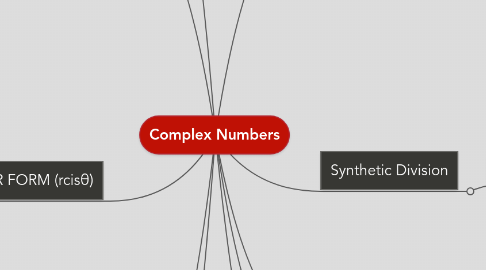
1. z = x+yi
1.1. i² = -1
2. Arithmatic Of Complex Numbers
2.1. CONJUGATE COMPLEX NUMBERS
2.1.1. MULTIPLY BY THE CONJUGATE TO DIVIDE
2.1.2. If z = a-bi, then z̅ =a + bi
2.1.3. (14+8i) ÷ (2+3i)
2.1.4. ((14+8i) ÷ (2+3i)) ×((2-3i) ÷(2-3i)) (FOILS AGAIN, WRITE AS FRACTION
2.1.5. = 4-2i
2.2. ADDITION
2.2.1. (2+3i) + (2-5i) = 7+i
2.3. SUBTRACTION
2.3.1. (-7-3i) - (2-5i) = -9+2i
2.4. MULTIPLICATION
2.4.1. (2+3i)(4-2i)
2.4.2. =8 +8i +6
2.4.3. =14+6
3. POLAR FORM (rcisθ)
3.1. DOMI ÷ out, × in 53.1° ÷ 180 × π = 0.927 2.753 ÷ π × 180= 157.7°
3.2. z = χ+yi = rcosθ + rsinθi =r(cosθ + isinθ) =rcisθ (Polar Form)
3.3. 360° = 2π 180° = π 90° = π∕2 30° = π∕4 15° = π∕8
4. COMPLEX ROOTS
4.1. Equations in the form of Z¬n=a, where ’a’ is a complex number or ¬n√a
4.1.1. 1- Convert to polar
4.1.1.1. Z³ = -8
4.1.1.2. Z³ = 8cis180°
4.1.2. 2 - Let rcisθ be a solution
4.1.2.1. (rcisθ)³ = 8cis180°
4.1.2.2. r³cis3θ = 8cis180°
4.1.2.3. r³ = 8 and 3θ = 180
4.1.2.4. 2 = 2 and θ = 60
4.1.3. Find number of soln. according to exponent thing (Z³ so 3 soln). All solutions are evenly spaced around argan diagram
5. De Moivre’s Theorm
5.1. χ¬n = (r¬χ)cis(χθ)
6. Completing the square
6.1. A useful technique for quadratic equations that aren't factorisable or ones that have pronumeral coefficients
6.1.1. χ² + 6χ -16 = 0
6.1.2. Take co-efficient of χ, half it, square it and add result to both sides
6.1.2.1. 6 ÷ 2 = 3
6.1.2.2. 3² = 9
6.1.3. χ²+6χ-16+9 = 9
6.1.4. x²+6χ+9 = 9+16
6.1.5. x²+6x+9 = 25
6.1.6. (x+3)² = 25
6.1.7. x+3 = ±5
6.1.8. x = -3±5
6.1.9. x = 2 or x= -8
7. Synthetic Division
7.1. If remainder =0, then it’s a factor
7.1.1. x³ + 3x² - 2x +1
7.1.2. Take coefficients
7.1.3. Multiply each bottom row number by multiplier, and add to top row number
7.1.4. 1 3 -2 1
7.1.5. ×-1 -1 -2 4
7.1.6. 1 2 -4 r5
8. Remainder Theorm
8.1. When a ploynomial p(x) is divided by (x-a), the remainder will be p(a)
9. Factor Theorm
9.1. (x-a) will be a factor of p(x) if and ONLY if p(a) = 0
10. Irrational Equations
10.1. SURD is an IRRATIONAL root of a RATIONAL number
10.1.1. ALWAYS CHECK TO SEE IF ITS AN ANSWER
10.1.2. CONJUGATE SURDS is if a+√b is a complex SURD, then it's conjugate is a−√b
10.1.2.1. MULTIPLYING & DIVIDING √a√b = √a×b √a÷√b = √a÷b e.g (2+2√3)(√15-√12) =2√15 - 2√12 + 2√3 + √15 − 2√3√12 (FOILS) =2√15 − 2√12 + 2√45 - 2√36 =2√15 - 2√4√3 + 2√9√5 − 12 =2√15 - 4√3 - 6√5 − 12

